Leonardo da Vinci: recent miracles of science and restoration
Salvator Mundi and the Magi’s Adoration by Leonardo da Vinci were in a bad shape. The same goes for a recently resurfaced drawing representing San Girolamo. Scientists have brought them back to life.
1. Leonardo da Vinci: Adoration of the Magi, a new San Girolamo and the Salvator Mundi
Leonardo da Vinci and The Adoration of the Magi: an interview with Marco Ciatti, who directed the restoration of the painting (by Antonio Carnevale)
Why would Leonardo da Vinci not complete his paintings? Vasari writes: “It is clear that Leonardo da Vinci, through his comprehension of art, began many things and never finished one of them, since it seemed to him that the hand was not able to attain to the perfection of art in carrying out the things which he imagined.” Many scholars have interpreted Vasari’s remark as a reference to the battle between body and mind, between the technical possibilities of representing nature and the perfection of nature itself. In this regard, Leonardo da Vinci’s inability to finish his paintings would derive from his belief in the impossibility to technically render his mental images, his ideas. However, Vasari’s remark can have a different meaning. The hand of the artist might not able to better his artwork because the artwork itself has already reached perfection. Anything added to the painting at this stage would make it weaker, drawing it nearer to a mere imitation and further from the work of the intellect.
A taste for the unfinished is not exclusive to Leonardo da Vinci. Throughout the history of art, Michelangelo and early Christian catacomb paintings are relevant examples. In the latter case, naturalistic precision of the late Hellenistic painting style could not properly convey the supernatural message of the new religion, hence the unfinishedness of the early Christian pictures. Despite these instances, Leonardo da Vinci’s preference for the unfinished remains unique, since it is especially difficult to pinpoint the reasons for this artistic choice in his work. In fact, a quest for those reasons has been the starting point for many scholars to study Leonardo da Vinci’s paintings. The restoration of The Adoration of the Magi at the Uffizi Gallery, one of the greatest masterpieces of the artist both in terms of actual dimensions and artistic achievement, has offered a great chance to understand his taste for the unfinished.

We discussed the subject with Marco Ciatti – head of the Opificio delle Pietre Dure in Florence – who directed the restoration of the painting from 2012 until its end in 2017 along with Cecilia Frosinini. The results of this long effort were presented last November in an international symposium at the Accademia dei Lincei in Rome titled Leonardo da Vinci and his Circle: Painting Technique in the Light of Restorations and Scientific Studies.
What were the main reasons for this restoration?
Marco Ciatti: On the one hand, the restoration was needed to consolidate the wooden support of the painting. On the other hand, it made the picture more legible by removing unoriginal layers of different materials that were concealing the figures–and meanings–initially intended by the artist.
What emerged from the more legible portions?
Marco Ciatti: Before the restoration, the individual figures were almost undefined, some barely stood out. There were even bleached paint patches. More generally, legibility of all expressive values was greatly penalized, and the strong chiaroscuro was almost gone. The spread of colored materials and patinas was creating a flattening effect. For example, it was removing any depth of the background, which actually opens towards a landscape. The immersion of the figures in the wider environment is one of Leonardo da Vinci’s typical aesthetic choices.
What did you find out about the painting being unfinished?
Marco Ciatti: Before the restoration we suspected that the various incomplete parts were quite randomly distributed over the painting with different levels of detail. Throughout the works this suspicion turned out to be certainty.

Leonardo da Vinci, Adoration of the Magi, 1481, before the restoration. 
Leonardo da Vinci, Adoration of the Magi, 1481, after the restoration.
Could you elaborate on this point?
Marco Ciatti: Contrary to many artists of the same period, Leonardo da Vinci would not start a painting from the top before finishing at the bottom. He would rather assign different levels of detail to specific areas, distributing them like spots on a leopard skin. I have been lucky enough in my career to direct the restoration of two great unfinished masterpieces: this painting of Leonardo da Vinci and The Madonna of the Baldacchino by Raphael in 1991. The unfinishedness of the latter is somehow more straightforward than that of The Adoration of the Magi. Raphael had a clear painting process, from top to bottom of the painted surface, which was progressively completed to a similar level of detail. We easily found out where the artist had stopped the completion of the layers. On the contrary, Leonardo da Vinci’s painting comprises of both parts that are barely sketched and some that are finished to the greatest accuracy. His modus operandi was intuitive, with barely any order or plan, completely different from the very systematic approach of Raphael.

Leonardo da Vinci, The Adoration of the Magi, 1481, detail. During restoration. 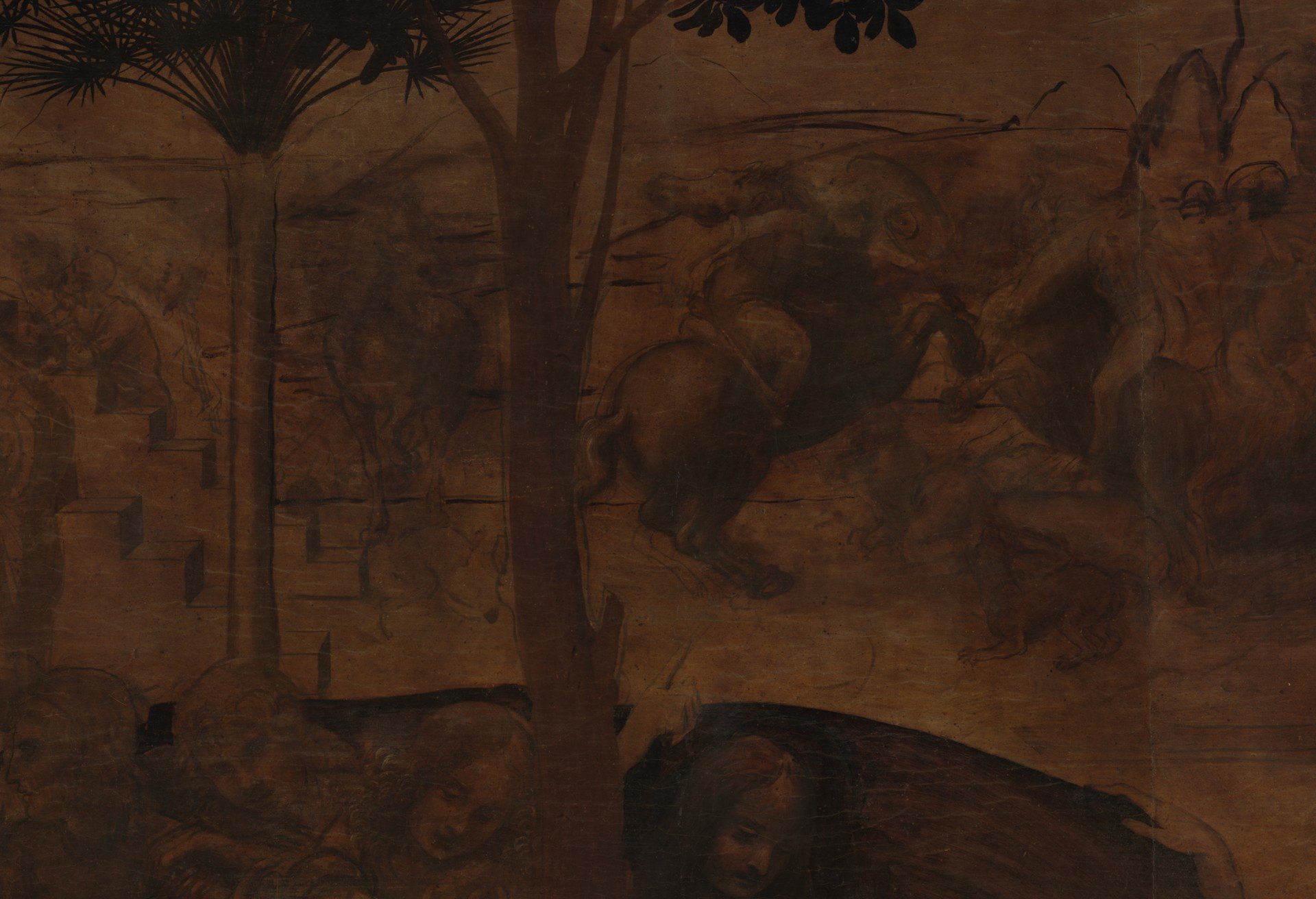
Leonardo da Vinci, The Adoration of the Magi, 1481, detail. Before restoration.
Did we learn about this characteristic of Leonardo da Vinci’s practice thanks to the restoration?
Marco Ciatti: Although scholars had clues about the way Leonardo da Vinci would approach his paintings, the restoration made his modus operandi especially clear. His Saint Girolamo is a good example of Leonardo da Vinci’s unfinished work, but its complexity does not compare to The Adoration of the Magi, in which there are about 70 figures moving in the picture as opposed to only one in the depiction of the saint.
Did the restauration bring Leonardo da Vinci’s preparatory drawing to light?
Marco Ciatti: Yes, especially his drawing of perspective. For example, we discovered he sketched the entire perspective grid with great precision to cover the full panel, adopting a structure dear to Alberti. The visual cone is clearly traced, and all the lines converge to a single vanishing point located on the main column in the golden ratio to the length of the panel. During the restoration we also found out that he had put a nail on the vanishing point to draw the perspective lines with ropes.
What were the next steps after sketching the perspective grid?
Marco Ciatti: Leonardo da Vinci would then work on a layer of gesso mixed with glue. An X-ray scan of this layer shows his unusual approach to the preparation of the panel, with vegetal fibers such as tow used to glue the joints. This was a pioneering technique at the time, and only in the following century did artists start to use this material to replace normal canvas to fill the joints. Leonardo da Vinci would also add very small pieces of yarn, possibly made of wool to the gesso and glue mixture, which appear as scattered dots on the preparatory layer. After sanding the panel, the artist would start drawing the figures with a brush, and sketch some of the shadows and volumes in light blue. A second preparatory layer would follow, which we dubbed “imprimitura,” and consisted of white lead oil with small quantities of yellow pigment to obtain an ivory tint. This layer was semi transparent and the drawing underneath could still be seen by the artist, who would continue with very fast brush sketches in darker brown. This stage is especially surprising, as it is clear how he would improvise these figures with the same nonchalant attitude of his pencil drawings on paper. One should keep in mind that artists at the time would approach painting in a very different way, rationally and slowly translating the preparatory cartons onto the final panel. Leonardo da Vinci would instead be very intuitive directly on the panel, coming back to the fast sketches on it multiple times. For example, the horse on the right hand side of the painting shows five different sketched faces, and god knows how many more he would have wanted to paint. The freedom of his approach is just amazing.

Leonardo da Vinci, Adoration of the Magi, 1481, detail after the restoration. 
Leonardo da Vinci, Adoration of the Magi, 1481, detail before the restoration.
Are you saying that Leonardo da Vinci would never use a preparatory carton?
Marco Ciatti: This is a paradox. The analysis of the painting suggests that he would draw the figures directly on the panel, sketching and finishing them at the same time. Yet, it seems impossible that he would never prepare the composition beforehand, as improvising a painting of such great dimensions (originally 2.40 meters per side) without previous studies is out of the question. He must have sketched the composition prior to the panel, for example in the famous study of The Adorazione at The Uffizi Gallery, with shows the perspective lines already outlined.
What else did you conclude during your work on this painting?
Marco Ciatti: First of all, what an incredible pioneer Leonardo da Vinci was. Let’s not forget that artists like Neri di Bicci, who would still draw old fashioned pictures of saints, were still active in Florence in the same period. Leonardo da Vinci’s daring compositions of figures, all with different attitudes and moves, with a psychological interplay between them, are at least 30 years ahead of his time.
In the beginning of the 3rd part of Lives of the Most Excellent Painters, Sculptors, and Architects, Vasari writes that Leonardo da Vinci opens a new season in art history: the modern manner.
Leonardo da Vinci, who, giving a beginning to that third manner which we propose to call the modern–besides the force and boldness of his drawing, and the extreme subtlety wherewith he counterfeited all the minutenesses of nature exactly as they are–with good rule, better order, right proportion, perfect drawing, and divine grace, abounding in resources and having a most profound knowledge of art, may be truly said to have endowed his figures with motion and breath.
Marco Ciatti: This passage also came to my mind. The Adorazione of the Magi attests to Vasari’s words, and even though it is an early work by the artist (1481-82), it already presents many of the features of his later career. X-ray scans show a draft of the later Virgin of the Rocks (1483-86) in the bottom part of the painting. Next to the Madonna, one can find a bald head resembling the Saint Girolamo in the Vatican Museums. At the top of the panel, the battle of knights reminds of the famous Battle of Anghiari. One might wonder how Leonardo da Vinci had already thought of these works so much ahead of their completion. Hypotheses and studies by scholars will put forward some answers, attempting to know more about the incredible practice of Leonardo da Vinci. The restoration of a painting should not only be intended as an attempt to conserve the artwork, but also as the occasion to revamp the conversation about artists and their work.
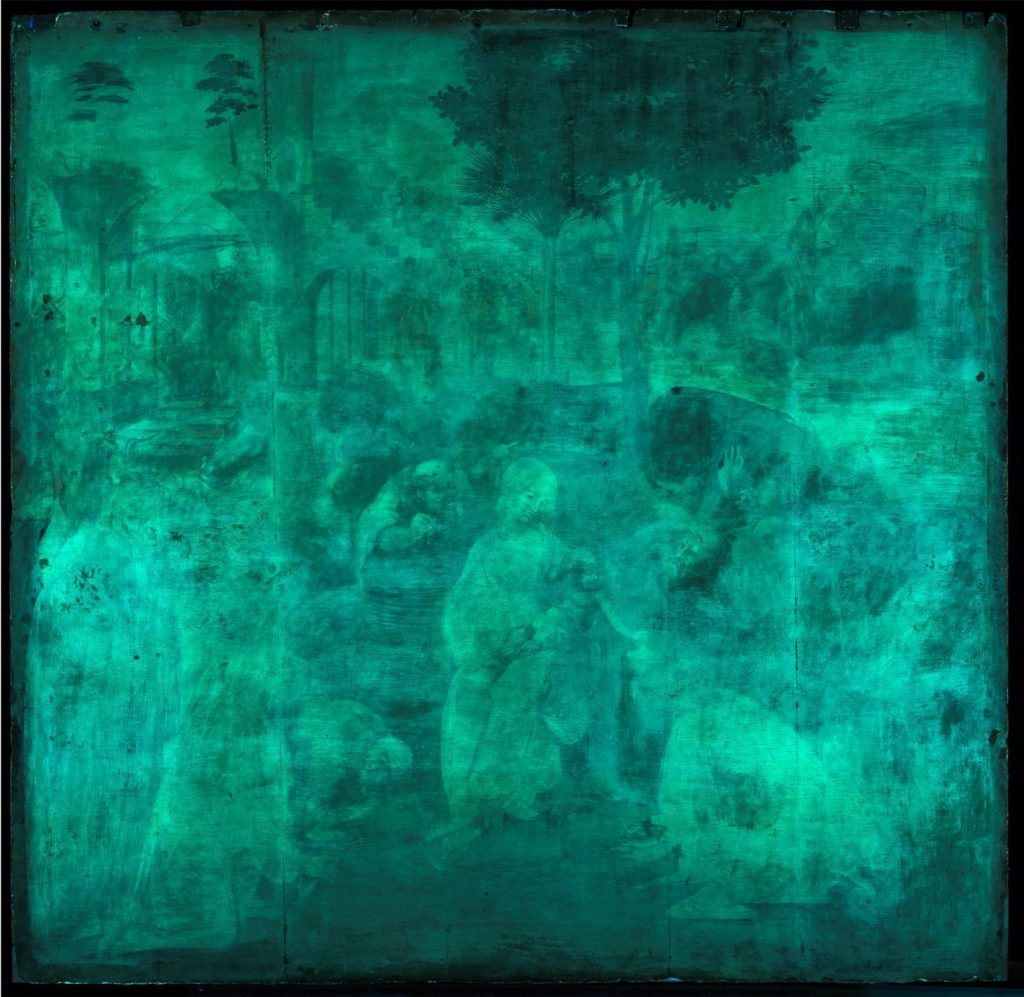
2. Leonardo da Vinci: Adoration of the Magi, a new San Girolamo and the Salvator Mundi
San Girolamo, a new drawing by Leonardo da Vinci (by Gianluca Poldi)
Just when you thought there was nothing more to discover about the over-studied Leonardo da Vinci, proper scientific research proves exactly the contrary. This is what recently happened after the analysis of some drawings by Leonardo and his assistants from the end of the 15th century/beginning of the 16th, belonging to the collection of the Veneranda Biblioteca Ambrosiana and including a few from the Codex Atlanticus. These drawings are currently on display at the Pinacoteca Ambrosiana, in the context of an exhibition curated by Benedetta Spadaccini, which featured 80 plus drawings by artists from the school of Leonardo (Boltraffio, Marco d’Oggiono, Bernardino Luini, Agostino da Lodi among others) and focused on the drawing techniques and styles taught at the master’s studio.
Among the most important discoveries in the exhibition are worn out sheets, especially a small picture of San Girolamo (47×42 mm) that sheds light on how Leonardo da Vinci approached the subject beside what can be concluded from the fantastic yet unfinished panel at the Vatican Museums. UV Fluorescence images of this small pen drawing of the kneeling saint, sketched with iron gall ink reveal how the body is portrayed: the left arm stretches to reach for the thin cross, while the saint hits his own chest with a rock held with the other hand.
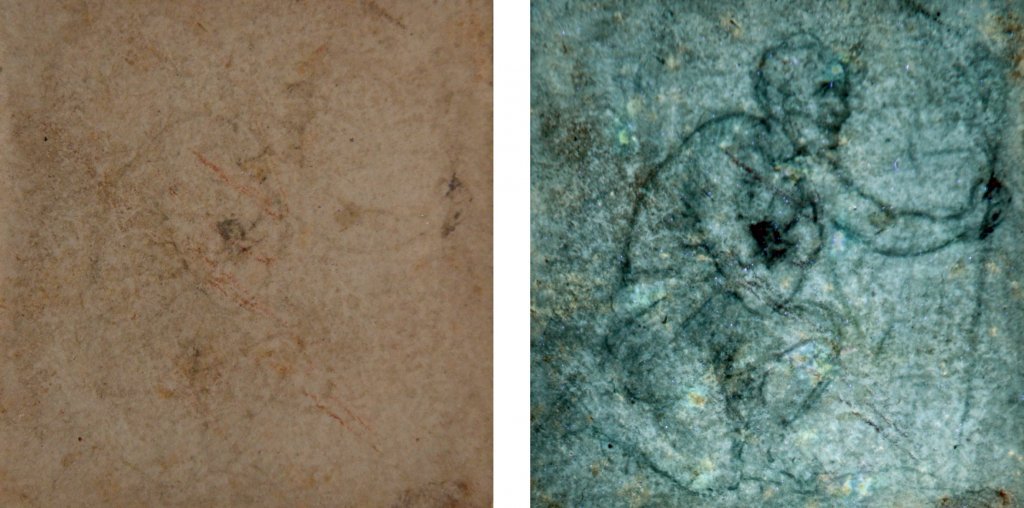
Another remarkable piece in the exhibition is the drawing of a woman’s head by the Maestro della Pala Sforzesca, somewhat of a late Gothic painter that nonetheless mastered drawing under the influence of his teacher Leonardo. Despite the fact that this work on beige coated paper is almost entirely lost today, UV images of it show the artist’s great chiaroscuro skills, with shades that were probably realised directly with his finger or a sponge.

inv. F263 inf. n. 63. UV Fluorescence b/w image. © Biblioteca
Ambrosiana and Gianluca Poldi.
The Bruker M6 Jetstream XRF scanner and spectrometer is but one of the instruments that allowed a clear visualisation of how the chemical elements were distributed on the support of the artwork, revealing some otherwise unreadable graphic characteristics and the types of inks used. Perhaps employed to scan drawings of this age for the first time, this machine and its remarkable precision (approx 10 micron, that is hundredths of a millimeter) was crucial in the investigation of the thinnest metal-point marks on paper.
Undoubtedly, Leonardo da Vinci’s metal-point drawing skills were unmatched. He used gold and silver-point (a copper alloy) for the most refined sheets, or lead and tin point for rougher, quicker sketches. The analysis of his pictures of some detailed man’s heads has shown that he especially favoured lead-point and black marks for the basic preparation of more complex drawings, which were eventually completed with a pen.
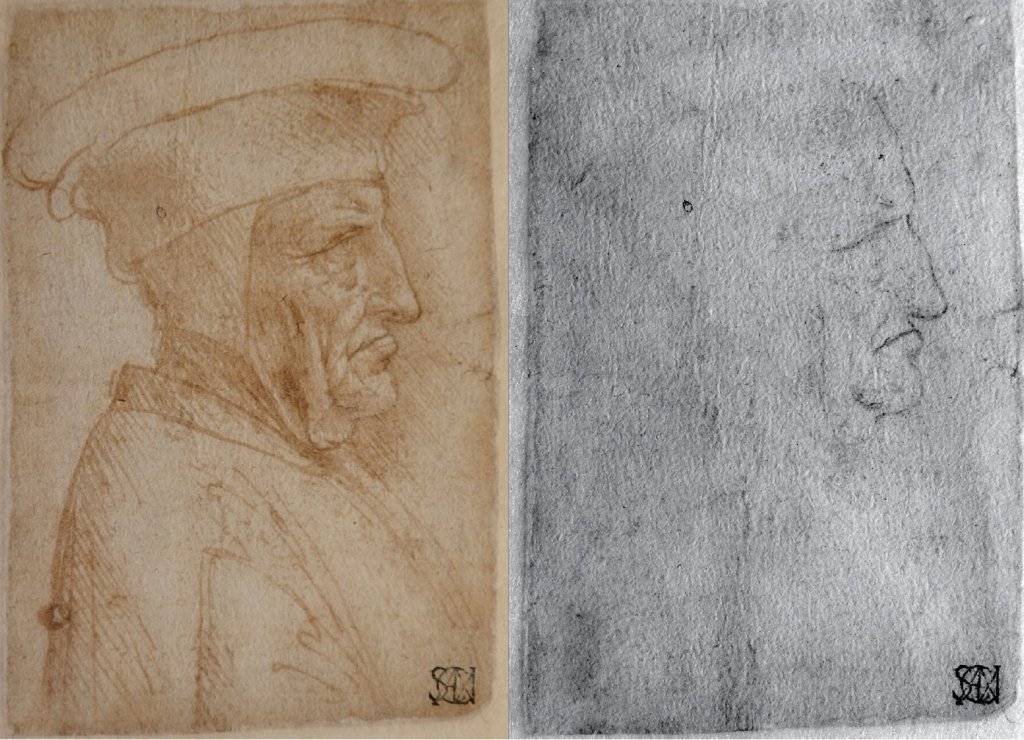

Metal-point drawing requires the paper to be coated in order for the tool to leave a mark on the surface. These marks can range from grey or brownish/grey to black for lead-point, with white, blue, red, rose, and sometimes beige paper coats.
When it comes to drawing, Leonardo da Vinci was a tireless experimenter. He not only put all that came to his vivid mind onto paper through sketches and writings, but he also challenged himself with all the drawing techniques available at the time, as well as inventing his own. For example, he was the first to use red pencil on red coated paper, subtly playing with those hues to make the figures emerge. This delicate technique would sometimes require a second passage with a pen to reinforce the outlines, allowing the artist to go back to the same work for a different reading after some time had passed.
Leonardo’s use of pastel colours was possibly inspired by the work of Frenchman Jean Perréal, also known as Jean de Paris and mentioned by Leonardo in the Codex Atlanticus in the passage dubbed Memorandum Ligny (also on display in the exhibition at Pinacoteca Ambrosiana). Leonardo was able to perfect the technique of pastels to the point where many 16th century artists would adopt it thanks to him, including the skilled Giovanni Antonio Boltraffio, who was one of his most gifted pupils and allegedly his closest collaborator in the realisation of the popular Salvator Mundi.
Leonardo would also extensively enjoy the silverpoint drawing technique, often combining it with blue coated paper. The use of this expensive instrument, sometimes referred to as the “scratch,” is documented by the artist himself in a note about the theft of the tool from Boltraffio’s studio by the young apprentice Gian Giacomo Caprotti da Oreno, also known as Il Salai:
On April 2, having left his silver scratch worth 24 coins on top of a drawing, Gian Antonio [Boltraffio] was robbed of it by Giacomo
Gian Giacomo Caprotti da Oreno was a recidivist apprentice indeed, as Il Salai had stolen another silverpoint from Marco d’Oggiorno just a few months earlier.
3. Leonardo da Vinci: Adoration of the Magi, a new San Girolamo and the Salvator Mundi
Salvator Mundi: is it a restoration masterpiece? (by Gianluca Poldi)
The work of a restorer has never been rated as much as in the case of Leonardo da Vinci’s Salvator Mundi, sold at Christie’s on 15th November 2017. Lets assume it makes sense to calculate the price of a work of art per square meter. Paying 450.3 millions dollar – auction house fees included – for a painted wooden board measuring 65.5 x 45.1 cm means that every squared centimeter of that painting costs you $154.000. The price of course embeds the “not Leonardo” parts, hence the parts retouched by Dianne Dwyer Modestini, who masterly restored the piece.
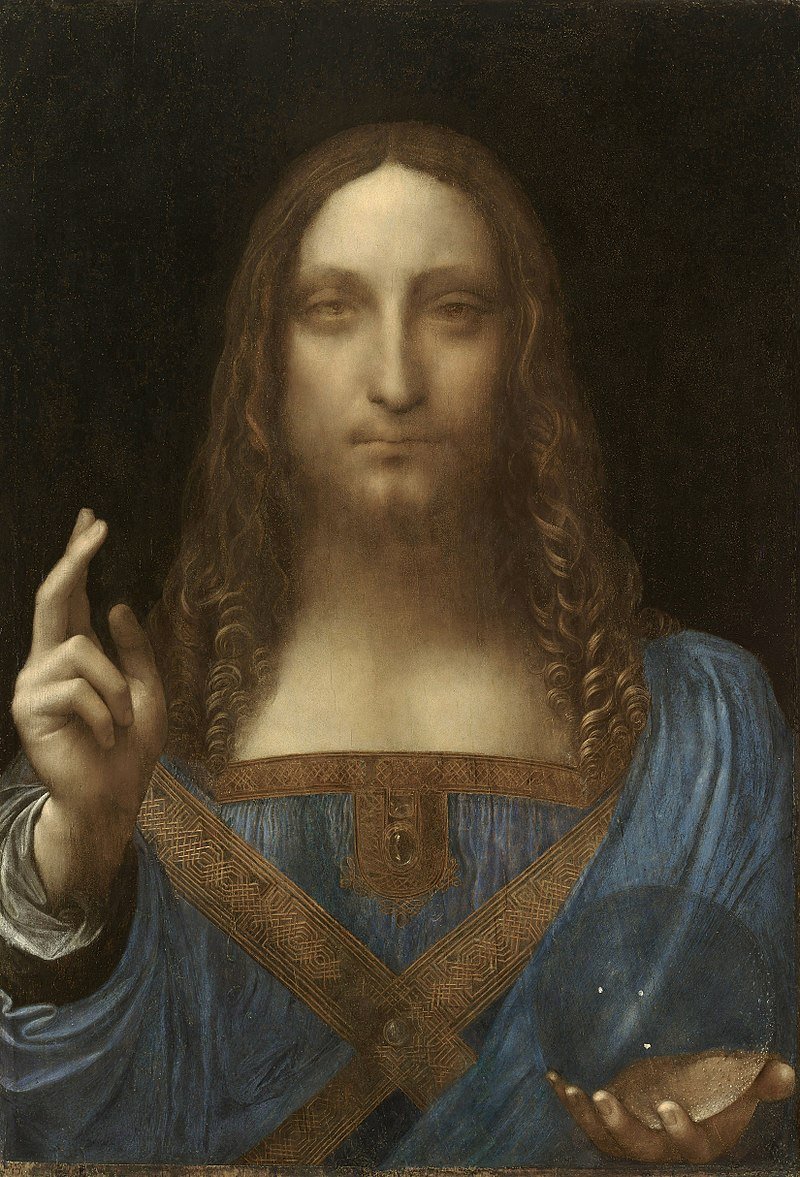
We are not questioning the painting’s authenticity: stylistically and technically speaking this Salvator Mundi is coherent with Leonardo da Vinci’s practice, nevertheless we can’t exclude some of his best pupils played a role in the making of it – someone suggested Boltraffio. Luke Syson, who curated the smashing exhibition dedicated to Leonardo at the London National Gallery in 2011, personally described the work in the exhibition’s catalogue attributing it to he master. Pietro Marani, a distinguished expert on Leonardo, confirms that The Salvator Mundi, now in the property of the Government of the United Arab Emirates, is an autograph painting by Leonardo da Vinci, even if he points out the work is not in a perfect state of preservation. Precisely Syson wrote that the “re-emergence of this picture, cleaned and restored to reveal an autograph work by Leonardo, […] comes as an extraordinary surprise”. But in the above mentioned catalogue he also wrote that the “reasons for such abundant over-paint are also clear: though both hands are well preserved, elsewhere the picture has suffered” and “it has also been aggressively over-cleaned, with some abrasion of the whole picture surface and especially in the face and hair of Christ”.


As proved by the image published in the ‘vanity catalogue’ dedicated by Christie’s to the fabulous lot (apparently they were expecting to sell it in the area of 100 millions), the recent cleaning revealed a long vertical crack and other evident losses of painted surface. They probably were due to the movement of the wood occurred during the centuries. The painting’ state of conservation is clarified by the technical images carried out by Art Analysis & Research, who produced Infra-Red Reflectography and X-Rays Radiography.
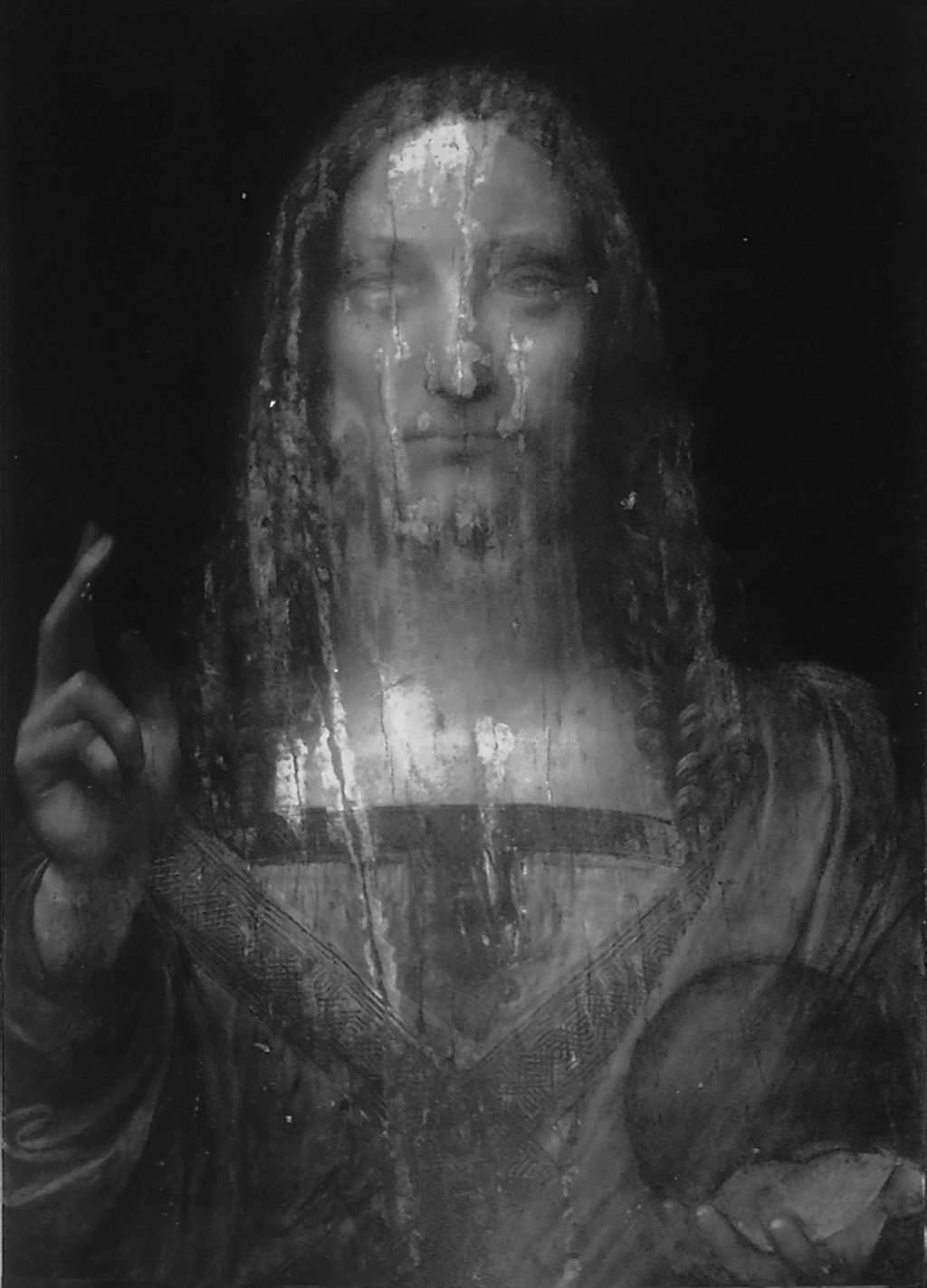

As many other works by the master, Leonardo da Vinci’s Salvator Mundi was painted on a walnut support; and not on a poplar one, generally employed by Italian artists at that time. IRR shows the lack of painting in many areas and also some small changes. There’s a little shift in the right hand thumb and some variations in the border of the cross-band on the chest and on the central decoration. Technically, we may affirm that the attribution to Leonardo is coherent with the results of the scientific analysis; but this coherency doesn’t rely on the use of high quality natural ultramarine (lapis lazuli), as someone stated; it is known that many other masters at that time were using the same kind of pigment. Rather, the painting is to be attributed to Leonardo on account of: a) under-drawing; b) the peculiar layering of pigments; c) the type and quality of the brushstrokes, which are perfectly fused together in the original and better preserved areas.

Having said so, would it be possible to account how much of lost painted surface was retouched during the restoration? According to the images available, we may estimate that more than 10% of the original painted surface of Christ’s face, neck, hair, dress and black background is by the hand of the restorer. Leonardo and the previous owner of the painting thank Dianne Dwyer Modestini. She had an impressive ability in recreating Leonardo’s ‘sfumato’ where needed, cleverly ‘interpreting’ what survived of the original image. The face of Leonardo Salvator Salvator was surely more simple to integrate than the Christ’s head of the Last Supper in Milan, whose interpretation of the shadows and of the whole head is still not convincing. But now that question is, what would be the price of the retouched parts of this extraordinary painting? Or, to put it in another way, how much would you pay for a 10% of a Leonardo by a distinguished restorer such as Dianne Dwyer Modestini?
November 17, 2022
